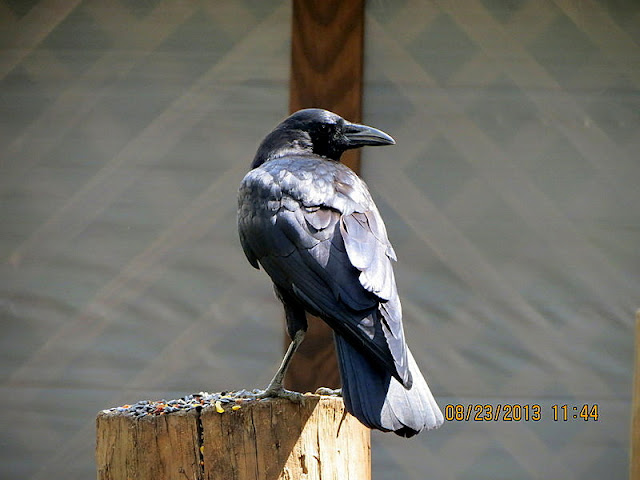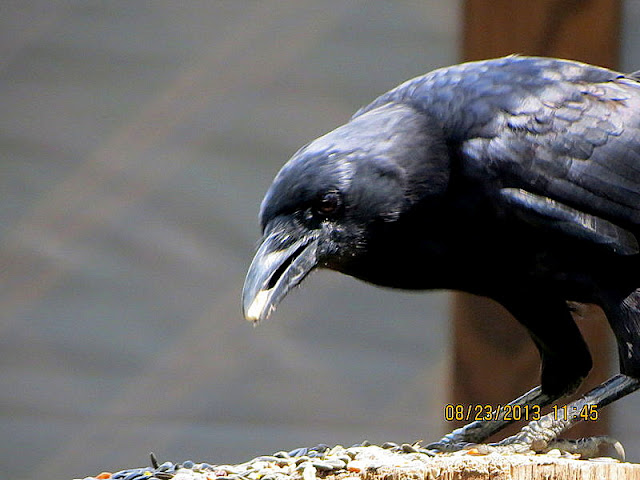Hi Everybody!!
Good Morning from Rainbow Creek. I know I was just talking about the end of summer last night, but I did not expect to walk out and see blankets of white ice! Yes, there was lots of ice but it was all in the sky as You will see in your photostudy below. Must be the changing of the seasons with all the weather oddities going on. The ice clouds are called:
Cirrocumulus (info below).
Today is Mom's birthday, so I walked around the grounds and shot a few of her favorite things to share with You. Wouldn't You know, out came the baby crow for the Party. Enjoy!A Blanket of Ice

http://en.wikipedia.org/wiki/Cirrus_cloud
Cirrus cloud
From Wikipedia, the free encyclopedia
Cirrus (cloud classification symbol: Ci) is a genus of atmospheric cloudgenerally characterized by thin, wispy strands, giving the type its name from the Latin word cirrus meaning a ringlet or curling lock of hair.[1][2]The strands of cloud sometimes appear in tufts of a distinctive form referred to by the common name of "mares' tails".[3]
Cirrus generally appears white or light gray in color. It forms when water vapor undergoes deposition at altitudes above 5,000 m (16,500 ft) in temperate regions and above 6,100 m (20,000 ft) in tropical regions. It also forms from the outflow of tropical cyclones or the anvils ofcumulonimbus cloud. Since cirrus cloud arrives in advance of the frontal system or tropical cyclone, it indicates that weather conditions may soon deteriorate. While it indicates the arrival of precipitation (rain), cirrus cloud per se produces only fall streaks (falling ice crystals that evaporate before landing on the ground).
Jet stream-powered cirrus can grow long enough to stretch across continents, but it remains only a few kilometers deep.[4] When visible light interacts with the ice crystals in cirrus cloud, it produces optical phenomena such as sun dogs and haloes. Cirrus is known to raise the temperature of the air beneath the main cloud layer by an average of 10 °C (18 °F). When the individual filaments become so extensive that they are virtually indistinguishable from one another, they form a sheet of high cloud called cirrostratus. Convection at high altitudes can produce another high based genus called cirrocumulus, a pattern of small cloud tufts that contain droplets of supercooled water.
Cirrus clouds form on other planets, including Mars, Jupiter, Saturn, Uranus, and possibly Neptune. They have even been seen onTitan, one of Saturn's moons. Some of these extraterrestrial cirrus clouds are composed of ammonia or methane ice rather than water ice. The term cirrus is also used for certain interstellar clouds composed of sub-micrometer sized dust grains.
Cirrocumulus
Main article: Cirrocumulus cloud
Cirrocumulus clouds form in sheets or patches[42] and do not cast shadows. They commonly appear in regular, rippling patterns[40] or in rows of clouds with clear areas between.[2]Cirrocumulus are, like other members of the cumuliform category, formed viaconvective processes.[43] Significant growth of these patches indicates high-altitude instability and can signal the approach of poorer weather.[44][45] The ice crystals in the bottoms of cirrocumulus clouds tend to be in the form of hexagonal cylinders. They are not solid, but instead tend to have stepped funnels coming in from the ends. Towards the top of the cloud, these crystals have a tendency to clump together.[46] These clouds do not last long, and they tend to change into cirrus because as the water vapor continues to deposit on the ice crystals, they eventually begin to fall, destroying the upward convection. The cloud then dissipates into cirrus.[47] Cirrocumulus clouds come in four species: stratiformis, lenticularis, castellanus, and floccus.[44] They are iridescent when the constituent supercooled water droplets are all about the same size.[45]
My Green Yard
The new baby squirrel
A few Hummers:
The Doves:
The Love Doves
A Happy Couple on the wire
The Lonesome Dove
11:00 Sun
Crape Myrtle Blooms
The Baby Crow growing in his head feathers for Fall/Winter
http://en.wikipedia.org/wiki/Crow
Crow
From Wikipedia, the free encyclopedia
| Crow | |
|---|---|
 | |
| American Crow (Corvus brachyrhynchos) | |
| Scientific classification | |
| Kingdom: | Animalia |
| Phylum: | Chordata |
| Class: | Aves |
| Order: | Passeriformes |
| Family: | Corvidae |
| Genus: | Corvus Linnaeus, 1758 |
Intelligence
As a group, crows show remarkable examples of intelligence. Natural history books from the 18th century recount an often-repeated, but unproven anecdote of "counting crows" — specifically a crow whose ability to count to five (or four in some versions) is established through a logic trap set by a farmer.[8][9] Crows and ravens often score very highly on intelligence tests. Certainspecies top the avian IQ scale.[10] Wild hooded crows in Israel have learned to use bread crumbs for bait-fishing.[11] Crows will engage in a kind of mid-air jousting, or air-"chicken" to establish pecking order. Crows have been found to engage in feats such as sports,[12] tool use, the ability to hide and store food across seasons, episodic-like memory, and the ability to use individual experience in predicting the behavior of environmental conspecifics.[13]
One species, the New Caledonian Crow, has also been intensively studied recently because of its ability to manufacture and use its own tools in the day-to-day search for food. These tools include "knives" cut from stiff leaves and stiff stalks of grass.[14]Another skill involves dropping tough nuts into a trafficked street and waiting for a car to crush them open.[15][16] On October 5, 2007, researchers from the University of Oxford, England, presented data acquired by mounting tiny video cameras on the tails of New Caledonian Crows. It turned out that they use a larger variety of tools than previously known, plucking, smoothing, and bending twigs and grass stems to procure a variety of foodstuffs.[17][18] Crows in Queensland, Australia, have learned how to eat the toxic cane toad by flipping the cane toad on its back and violently stabbing the throat where the skin is thinner, allowing the crow to access the non-toxic innards; their long beaks ensure that all of the innards can be removed.[19][20]
Crows have demonstrated the ability to distinguish individual humans by recognizing facial features.[21]
...this is brendasue signing off from Rainbow Creek. See You next time! I have not had any rain YET.
The baby catfish are barely holding on. I remain the "Only Rainmaker" on Rainbow Creek!
Happy Birthday MOM!
O+O
































































































No comments:
Post a Comment
Hi Everybody! Please say hello and follow so I know you are here! Due to the inconsideration of people trying to put commercials on my blog comment area, I have restricted use of anonymous posts. Sorry that some hurt all.
My public email is katescabin@gmail.com No spammers or trolls